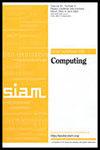Quantum Speedup for Graph Sparsification, Cut Approximation, and Laplacian Solving
IF 1.6
3区 计算机科学
Q3 COMPUTER SCIENCE, THEORY & METHODS
引用次数: 0
Abstract
SIAM Journal on Computing, Volume 51, Issue 6, Page 1703-1742, December 2022.Abstract. Graph sparsification underlies a large number of algorithms, ranging from approximation algorithms for cut problems to solvers for linear systems in the graph Laplacian. In its strongest form, “spectral sparsification” reduces the number of edges to near-linear in the number of nodes, while approximately preserving the cut and spectral structure of the graph. In this work we demonstrate a polynomial quantum speedup for spectral sparsification and many of its applications. In particular, we give a quantum algorithm that, given a weighted graph with [math] nodes and [math] edges, outputs a classical description of an [math]-spectral sparsifier in sublinear time [math]. This contrasts with the optimal classical complexity [math]. We also prove that our quantum algorithm is optimal up to polylog-factors. The algorithm builds on a string of existing results on sparsification, graph spanners, quantum algorithms for shortest paths, and efficient constructions for [math]-wise independent random strings. Our algorithm implies a quantum speedup for solving Laplacian systems and for approximating a range of cut problems such as min cut and sparsest cut.
图稀疏化、切近似和拉普拉斯求解的量子加速
SIAM Journal on Computing, vol . 51, Issue 6, Page 1703-1742, December 2022。摘要。图稀疏化是大量算法的基础,从切问题的近似算法到图拉普拉斯线性系统的求解。在其最强的形式中,“谱稀疏化”将边缘的数量减少到节点数量的近似线性,同时近似地保留了图的切割和谱结构。在这项工作中,我们展示了谱稀疏化的多项式量子加速及其许多应用。特别地,我们给出了一个量子算法,给定一个带有[math]节点和[math]边的加权图,在亚线性时间[math]输出一个[math]-谱稀疏器的经典描述。这与最优的经典复杂性[数学]形成了对比。我们还证明了我们的量子算法是最优的,直到多对数因子。该算法建立在稀疏化、图形生成、最短路径的量子算法和[数学]独立随机字符串的有效构造的现有结果的基础上。我们的算法意味着求解拉普拉斯系统和近似一系列切割问题(如最小切割和最稀疏切割)的量子加速。
本文章由计算机程序翻译,如有差异,请以英文原文为准。
求助全文
约1分钟内获得全文
求助全文
来源期刊

SIAM Journal on Computing
工程技术-计算机:理论方法
CiteScore
4.60
自引率
0.00%
发文量
68
审稿时长
6-12 weeks
期刊介绍:
The SIAM Journal on Computing aims to provide coverage of the most significant work going on in the mathematical and formal aspects of computer science and nonnumerical computing. Submissions must be clearly written and make a significant technical contribution. Topics include but are not limited to analysis and design of algorithms, algorithmic game theory, data structures, computational complexity, computational algebra, computational aspects of combinatorics and graph theory, computational biology, computational geometry, computational robotics, the mathematical aspects of programming languages, artificial intelligence, computational learning, databases, information retrieval, cryptography, networks, distributed computing, parallel algorithms, and computer architecture.
 求助内容:
求助内容: 应助结果提醒方式:
应助结果提醒方式:


